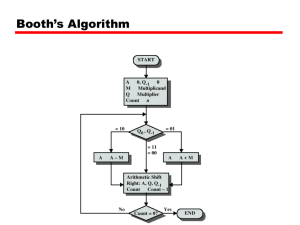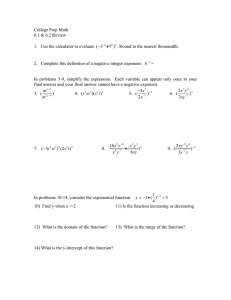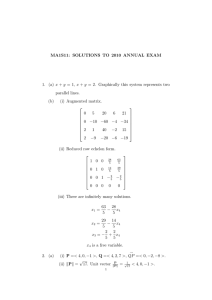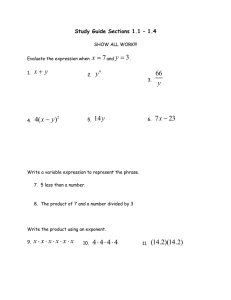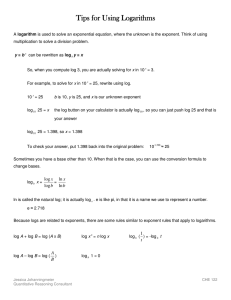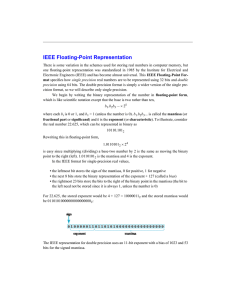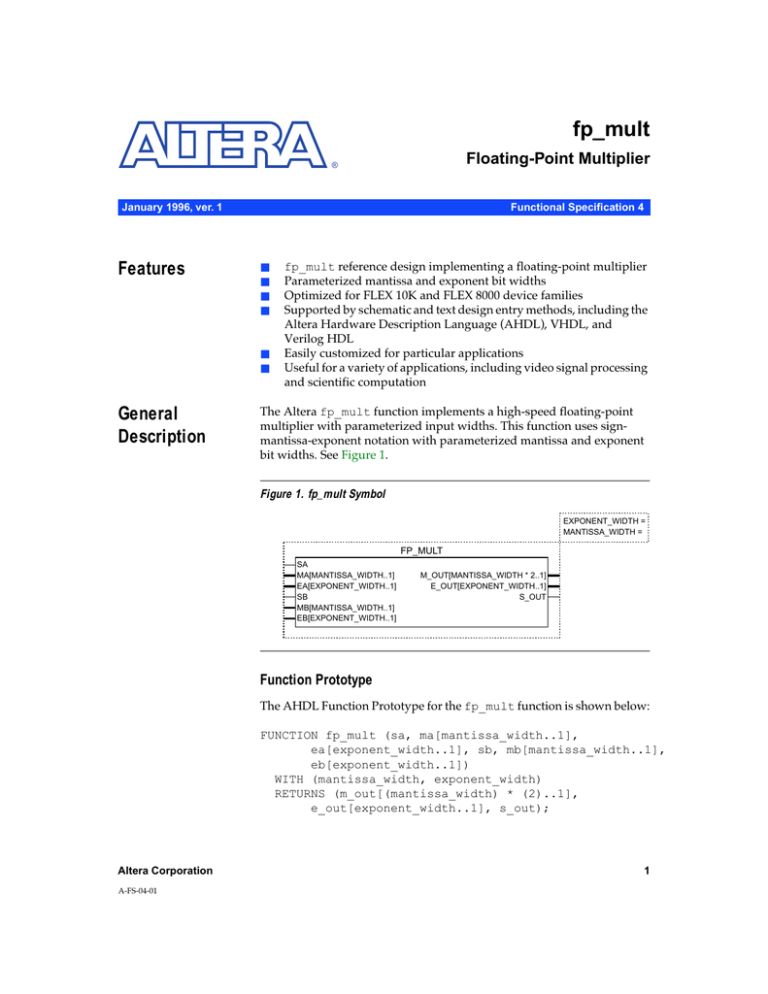
fp_mult
Floating-Point Multiplier
®
January 1996, ver. 1
Features
Functional Specification 4
■
■
■
■
■
■
General
Description
fp_mult reference design implementing a floating-point multiplier
Parameterized mantissa and exponent bit widths
Optimized for FLEX 10K and FLEX 8000 device families
Supported by schematic and text design entry methods, including the
Altera Hardware Description Language (AHDL), VHDL, and
Verilog HDL
Easily customized for particular applications
Useful for a variety of applications, including video signal processing
and scientific computation
The Altera fp_mult function implements a high-speed floating-point
multiplier with parameterized input widths. This function uses signmantissa-exponent notation with parameterized mantissa and exponent
bit widths. See Figure 1.
Figure 1. fp_mult Symbol
EXPONENT_WIDTH =
MANTISSA_WIDTH =
FP_MULT
SA
MA[MANTISSA_WIDTH..1]
EA[EXPONENT_WIDTH..1]
SB
MB[MANTISSA_WIDTH..1]
EB[EXPONENT_WIDTH..1]
M_OUT[MANTISSA_WIDTH * 2..1]
E_OUT[EXPONENT_WIDTH..1]
S_OUT
Function Prototype
The AHDL Function Prototype for the fp_mult function is shown below:
FUNCTION fp_mult (sa, ma[mantissa_width..1],
ea[exponent_width..1], sb, mb[mantissa_width..1],
eb[exponent_width..1])
WITH (mantissa_width, exponent_width)
RETURNS (m_out[(mantissa_width) * (2)..1],
e_out[exponent_width..1], s_out);
Altera Corporation
A-FS-04-01
1
FS 4: fp_mult Floating-Point Multiplier
Parameters
Parameters for the fp_mult function are provided in Table 1.
Table 1. fp_mult Parameters
Name
Default
Value
Description
exponent_width
7
Integers only Width of all exponents (in bits)
mantissa_width
8
Integers only Width of input mantissas (in bits)
Ports
Input and output ports for the fp_mult function are shown in Table 2.
Table 2. fp_mult Input & Output Ports
Port Type
Name
Description
Input
sa
Sign bit for the a input: 1 = positive, 0 = negative
Input
ma[mantissa_width..1]
Mantissa for the a input
Input
ea[exponent_width..1]
Exponent for the a input
Input
sb
Sign bit for the b input: 1 = positive, 0 = negative
Input
mb[mantissa_width..1]
Mantissa for the b input
Input
eb[exponent_width..1]
Exponent for the b input
Output
m_out[(mantissa_width)*(2)..1]
Mantissa for the output
Output
e_out[exponent_width..1]
Exponent for the output
Output
s_out
Sign bit for the output: 1 = positive, 0 = negative
Functional
Description
The fp_mult reference design implements a fast, flexible floating-point
multiplier that provides parameterized mantissa and exponent widths.
The multiplier and the floating-point format can be easily customized for
particular applications by modifying a copy of the AHDL Text Design File
(.tdf).
In floating-point functions, the sign bit represents the sign of the mantissa:
1 for positive, 0 for negative. The mantissa is a positive number less than
1. A 0 is implied to the left of the binary point. After normalization, the
most significant bit (MSB) is always 1. The exponent is represented in
excess 2(n-1) notation, where n is the number of bits in the exponent.
2
Altera Corporation
FS 4: fp_mult Floating-Point Multiplier
For example, the binary representation of the number 0.75 × 21 is shown
below. This example assumes 8 bits for the mantissa (M) and 7 bits for the
exponent (E). S represents the sign bit.
S = 1, M = 11000000, E = 1000001
Similarly, the binary representation of the number 0.625 × 2–1 is:
S = 1, M = 10100000, E = 0111111
Figure 2 shows a block diagram of the fp_mult floating-point multiplier.
Figure 2. fp_mult Block Diagram
In this figure, m represents mantissa_width and n represents exponent_width.
SA SB
EA
MA MB
m
m
EB
n
n
+
+
Fixed-Point
Multiplier
(LPM_MULT)
EXPONENT_OFFSET = 2(n – 1)
+
–
m×2
Post-Normalizer
m×2
S_OUT
Floating-Point
Multiplication
Altera Corporation
M_OUT
n
E_OUT
To multiply floating-point numbers, the mantissas are first multiplied
together with an unsigned integer multiplier. Then, the exponents are
added, and the excess value (exponent_offset) 2(n – 1) is subtracted
from the result. The sign of the output (s_out) is the XNOR of the signs of
the inputs (sa and sb). After multiplication has taken place, the postnormalizer normalizes the result, if necessary, by adjusting the mantissa
and exponent of the result to ensure that the MSB of the mantissa is 1.
3
FS 4: fp_mult Floating-Point Multiplier
Using the fp_mult function in a design produces a double precision
output (i.e., the mantissa in the result has twice the number of bits of either
input mantissa). Therefore, the result does not lose precision and does not
require rounding.
The mantissa must be post-normalized whenever floating-point numbers
are multiplied. As a double precision output is created, the implied
denominator of the mantissa fraction is squared in value, from 8 to 16 bits.
The denominator of the mantissa fraction is 65536 (= 216) in double
precision format, and 256 (= 28) in single precision. To retain as many
significant digits as possible for consequential floating point operations,
the result must be normalized.
To normalize the mantissa, the mantissa is shifted left (i.e., the mantissa is
multiplied by powers of 2). For each bit shifted left, the exponent must be
reduced by 1. The following example shows a number before
normalization and its normalized equivalent:
Unnormalized number: 0.0001011001110001 × 250
Normalized equivalent: 0.1011001110001000 × 247
Table 3 shows an example of floating-point multiplication. The subscript
“d” indicates that the number is a decimal number.
Table 3. Floating-Point Multiplication
Operation
Decimal Equivalent
(Exponent in Excess 0)
Binary
(Exponent in Excess 64)
Multiplication
(39 × 210d) × (203 × 26d)
(00100111.0 × 274) × (11001011.0 × 270)
Normalization
(0.609375 × 216d) × (0.79296875 × 214d)
(0.10011100 × 280) × (0.11001011 × 278)
Result
7917 × 2
0.0001111011101101 × 280
Normalize
63336 × 213d
0.1111011101101000 × 277
Decimal result
518,848,512
16d
Floating-Point
Representation
—
Floating-point numbers can be represented by many different notations.
The fp_mult reference design uses an implied leading zero for the
mantissa, with an unsigned m-bit mantissa, and n-bit exponent, where
m = mantissa_width and n = exponent_width. A separate sign bit
represents the sign of the mantissa.
The following examples of an 8-bit positive mantissa and a 7-bit exponent
assume mantissa_width = 8 and exponent_width = 7. The numbers
in Table 4 should be adjusted accordingly if different parameter values
are used.
4
Altera Corporation
FS 4: fp_mult Floating-Point Multiplier
An 8-bit positive mantissa allows fractions with numerators ranging from
0 to 255. The implied leading zero limits the range of the mantissa from 0
to 0.9961, and the separate sign bit allows the mantissa to have a value
from –0.9961 to +0.9961. Because the mantissa is in fractional form, having
an additional number of bits in the mantissa does not result in a larger
mantissa, but instead offers greater precision. Table 4 lists examples of
8-bit mantissas with implied leading zeros.
Table 4. 8-Bit Mantissas
Mantissa
Implied Zero
Binary Fraction
Decimal
Fraction
Decimal
11001110
0.11001110
11001110 / 100000000
206 / 256
0.80469
00001100
0.00001100
00001100 / 100000000
12 / 256
0.04688
10100001
0.10100001
10100001 / 100000000
161 / 256
0.62891
A 7-bit exponent is represented in excess 64 format—i.e., for an n-bit
exponent, the representation is excess 2(n – 1). Excess (or offset) format
allows both negative and positive exponents to be represented with
positive numbers, which results in simpler calculations for exponent
handling. To represent an exponent in excess 2(n – 1) format, add 2(n – 1) to
the value of the exponent. For example, to represent an exponent in excess
64 format, add 64 to the exponent; thus, the maximum value for the
exponent is +63, and the minimum value is –64. In excess 64 format, an
exponent of 10 is represented as 74, and an exponent of –10 is represented
as 54. The exponent 0 is represented as 64.
Examples of floating-point multiplication for 8-bit mantissa, 7-bit
exponent floating-point numbers are provided below. The subscripts “b”
and “d” indicate that the number is a binary or a decimal number,
respectively.
Example 1: Largest Positive Number
+11111111b 1111111b
= +0.11111111b × 2(1111111b – 1000000b)
0111111b
= +0.11111111b × 2
63d
= +0.11111111b × 2
55d
= +11111111.0b × 2
55d
= +255d × 2
= +9.187343239836d × 1018d
Altera Corporation
5
FS 4: fp_mult Floating-Point Multiplier
Example 2: Largest Negative Number
–11111111b 1111111b
= –9.187343239836d × 1018d
Example 3: Smallest Number (Closest to Zero)
±10000000b 0000000b
(0000000b – 1000000b)
= ±0.10000000b × 2
(0d – 64d)
= ±0.10000000b × 2
–64d
= ±0.10000000b × 2
–72d
= ±10000000.0b × 2
–72d
= ±128d × 2
= ±2.710505431214d × 10–20d
Example 4: Typical Value
–11000111b 1001001b
(1001001b – 1000000b)
= –0.11000111b × 2
1101b
= –0.11000111b × 2
9d
= –0.11000111b × 2
1d
= –11000111.0b × 2
= –199d × 2d
= –398d
Floating-Point
Error Detection
f
6
The fp_mult function does not check for error conditions such as
overflow and underflow because implementing error detection and
correction in a design can add significant delays to the circuit. Although
error detection can be implemented quickly, error correction causes long
delays because it requires the exponent and/or mantissa values to be
modified. Boundary conditions for the mantissa and exponent can also be
added by the designer. Error detection and correction, and boundary
conditions can be added to fp_mult by modifying the Logic Section of a
copy of the fp_mult.tdf file.
Go to MAX+PLUS II Help for more information about programming with
AHDL.
Altera Corporation
FS 4: fp_mult Floating-Point Multiplier
Overflow & Underflow Error Conditions
The most common floating-point errors are overflow and underflow.
Overflow occurs when the resultant exponent has a value greater than the
number of bits in exponent_width. For example, overflow occurs with
a 7-bit exponent when the resultant exponent is greater than 63.
To detect overflow in a design, an extra bit of precision in the exponent
must be carried when calculating the exponent of the output. With a 7-bit
exponent, overflow may have occurred if the MSB of the exponent is 1
after the exponents are added and 64 is subtracted from the result.
Overflow has occurred if the MSB of the exponent is 1 after the postnormalization correction. Therefore, the general AHDL equation for
overflow detection is as follows:
Overflow = <MSB of exponent after addition>
AND <MSB after excess 64 subtraction>
AND <MSB after post-normalization correction>;
Underflow occurs when the MSB of the exponent is equal to 0 after the
exponents are added and 64 is subtracted from the result, but equal to 1
after the post-normalization correction. With a 7-bit exponent, underflow
occurs when the exponent is less than –64. The general AHDL equation
for underflow is as follows:
Underflow = !<MSB after addition>
AND <MSB after post-normalization correction>;
Boundary Conditions
The values of the mantissa and/or exponent can be used to set boundary
conditions or to indicate error conditions such as not-a-number (NaN).
The NaN condition occurs as a result of invalid operations, such as
zero × infinity. Infinity can be represented in several ways, such as setting
the exponent to its largest value. The largest exponent cannot be used to
represent other numbers if it is used to represent infinity. Therefore, some
dynamic range is lost.
Table 5 shows the mantissa and exponent values used to set boundary
conditions and the NaN error condition.
Altera Corporation
7
FS 4: fp_mult Floating-Point Multiplier
Table 5. Boundary & NaN Error Conditions
Condition Type
Name
Sign
Mantissa
Exponent
Boundary
Zero
0
0
0
Boundary
–Zero
1
0
0
Boundary
Infinity
0
0
2(n – 1)
Boundary
–Infinity
1
0
2(n – 1)
Error
NaN
–
2(m – 1)
Anything except 0
The fp_mult reference design does not define boundary conditions or
check for the NaN error condition. Like the overflow and underflow error
conditions, boundary conditions and NaN detection can be added to
fp_mult by modifying the Logic Section of a copy of the fp_mult.tdf file.
®
2610 Orchard Parkway
San Jose, CA 95134-2020
(408) 894-7000
Applications Hotline:
(800) 800-EPLD
Customer Marketing:
(408) 894-7104
Literature Services:
(408) 894-7144
8
Altera, MAX, MAX+PLUS, and FLEX are registered trademarks of Altera Corporation. The following are
trademarks of Altera Corporation: MAX+PLUS II, AHDL, and FLEX 10K. Altera acknowledges the
trademarks of other organizations for their respective products or services mentioned in this document,
specifically: Verilog and Verilog-XL are registered trademarks of Cadence Design Systems, Inc. Mentor
Graphics is a registered trademark of Mentor Graphics Corporation. Synopsys is a registered trademark of
Synopsys, Inc. Viewlogic is a registered trademark of Viewlogic Systems, Inc. Altera products are protected
under numerous U.S. and foreign patents and pending applications, maskwork rights, and copyrights. Altera
warrants performance of its semiconductor products to current specifications in accordance with Altera’s
standard warranty, but reserves the right to make changes to any products and services at any time without
notice. Altera assumes no responsibility or liability arising out of the application or use of
any information, product, or service described herein except as expressly agreed to in
writing by Altera Corporation. Altera customers are advised to obtain the latest version of
device specifications before relying on any published information and before placing
orders for products or services.
Copyright 1996 Altera Corporation. All rights reserved.
Altera Corporation
Printed on Recycled Paper.


